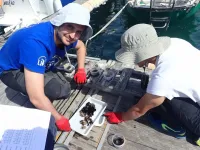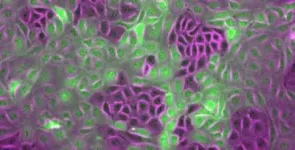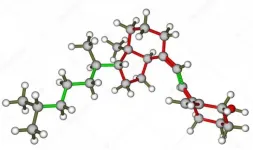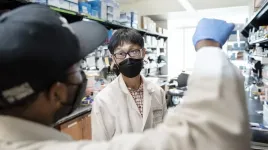(Press-News.org) An interdisciplinary group of Spanish scientists, bringing together biologists and chemists from the Universities of Seville, Huelva, the Autonomous University of Madrid and the Institute of Marine Sciences of Andalusia of the CSIC in Cadiz, have just published the results of their pioneering research studying the management of marinas. The group of scientists, led by the US professor José Manuel Guerra García, studied in detail the sediments in Andalusia's marinas and has proposed a new index, the MEPI (Marinas Environmental Pollution Index) to quantify the level of contamination in these ports.
There has been a proliferation of marinas in recent years, in Spain, other Mediterranean countries and in the rest of the world. Marinas are highly modified ecosystems that have a great impact on marine biota. On the one hand, they alter the area's hydrodynamism, damming ecosystem in and tending to concentrate pollutants (heavy metals, hydrocarbons, etc.). In addition, recreational boats can be responsible for transporting invasive species from one area to another, attached to the boats' hulls.
"It is essential to regulate these marinas. To this end, authorities need scientists to provide tools to manage these ecosystems in the best possible way. Ideally, we should try to build more environmentally sustainable ports and aim to establish minimum ecological quality levels enabling us to identify marinas that make efforts to control environmental conditions and make their waters and sediments higher quality than elsewhere", explains Professor Guerra.
Specifically, the MEPI index is based on parameters such as hydrocarbons, heavy metals, faecal coliforms, nitrogen, phosphorus, sulphur and biocides such as Irgarol, which are used as a base in the manufacture of the antifouling paints applied to prevent organisms from adhering to recreational boats. The MEPI index was developed using national and international sediment quality recommendations and reference values and ranges proposed by legislation in different countries around the world. Together with the new index, the authors have applied a simple and complete ecological analysis method to determine a port's quality in a holistic and integrated way, taking into account both chemical and biological parameters. For this purpose their models used not only the MEPI, but also values relating to the diversity of organisms living in the sediments, biotic indices measuring the quality of the seabed based on these organisms, and biotic pollution indices based on the number and abundance of invasive species. Thus, communities of organisms living on the bottom of the ports were studied, including both macrofauna (those larger than 0.5 mm such crustaceans, molluscs, annelid worms and echinoderms mainly), and meiofauna (smaller than 0.5 mm, mainly copepods and nematodes).
"These small animals that live in ports are the best 'whistleblowers' of port quality, making the role of biologists crucial in understanding how these ecosystems function. Depending on the species we find, we can tell how polluted a port has become," adds the researcher.
The study's innovative approach enabled the integration of both environmental parameters, where the role of chemists was key, and biological parameters as part of a holistic model. Based on all the indicators used, the researchers have proposed a total scoring system (the sum of each parameter's partial score) that allows the ecological quality status of a port to be established using a scale that is easy for authorities to interpret and in line with the European water quality directives. On this basis, colour-coded quality levels can then be established for each marina, ranging from red (very poor quality) to blue (excellent quality).
Thanks to this excellent work, in which the researcher Alejandro Fernández-Romero also participated, and based on the study of the marinas along the Andalusian coast, simple and integrated environmental quality assessment tools are now available for application in any marina anywhere in the world. The information provided can be key, for example, to awarding distinctions, such as the blue flag, to marinas that meet environmental quality requirements. Similarly, Dr. Guerra carried out several studies during his doctoral thesis which demonstrated that the creation of tunnels or hydrodynamic channels in ports, or ports designed with double entrances, such as the port of Ceuta, allow greater water renewal, increase oxygen levels and favour higher levels of biological diversity.
"We must try to move towards 'eco-sustainable' designs that minimise the negative impact of creating or remodelling a port. In this sense, both biologists and chemists can contribute invaluable input for engineers, ensuring they opt for coastal infrastructure designs that are more ecological and less harmful to marine flora and fauna", concludes José Manuel Guerra.
INFORMATION:
The giant star featured in this latest Hubble Space Telescope anniversary image is waging a tug-of-war between gravity and radiation to avoid self-destruction. The star, called AG Carinae, is surrounded by an expanding shell of gas and dust -- a nebula -- that is shaped by the powerful winds of the star. The nebula is about five light-years wide, which equals the distance from here to our nearest star, Alpha Centauri.
The huge structure was created from one or more giant eruptions several thousand years ago. The star's outer layers were blown into space, the expelled material ...
How do the billions of cells communicate in order to perform tasks? The cells exert force on their environment through movement - and in doing so, they communicate. They work as a group in order to infiltrate their environment, perform wound healing and the like. They sense the stiffness or softness of their surroundings and this helps them connect and organize their collective effort. But when the connection between cells is distrubeddisturbed, a situation just like when cancer is initiated, can appear.
Assistant Professor Amin Doostmohammadi at the Niels Bohr Institute, University of Copenhagen has investigated the mechanics of cell movement and connection ...
Etrasimod 2 mg treatment group achieved statistical significance in the percentage change in weekly peak pruritis (PP-NRS), in the change in Dermatology Life Quality Index (DLQI), and in the change in Patient-Oriented Eczema Measure (POEM)
Etrasimod 2 mg was generally well tolerated, consistent with data in previous trials
Park City, Utah, April 23, 2021 - Arena Pharmaceuticals, Inc. (Nasdaq: ARNA) today announced data at a late-breaking session at the American Academy of Dermatology VMX Experience. Etrasimod, a novel investigational drug candidate to treat moderate-to-severe atopic dermatitis (AD), demonstrated statistical significance in both clinician and patient reported outcomes in the ADVISE Phase 2b clinical trial. Etrasimod is a highly selective, once-daily, oral sphingosine ...
Paper Title: Safety of Tranexamic Acid in Hip and Knee Arthroplasty in High-risk Patients
Journal: Anesthesiology
Authors: Jashvant Poeran MD, PhD, Director of the Center for Clinical and Outcomes Research, and Associate Professor of Population Health Science & Policy and Orthopedics at the Icahn School of Medicine at Mount Sinai; Calin S. Moucha, MD, Chief of Adult Reconstruction & Joint Replacement Surgery at Mount Sinai Hospital, and Associate Professor of Orthopedics at the Icahn School of Medicine at Mount Sinai; and other coauthors.
Bottom Line: The use of the drug tranexamic acid is commonplace in patients undergoing hip or knee replacement surgery to reduce blood loss. However, this drug works by promoting clotting and safety concerns exist when used in certain high-risk ...
By Karina Toledo | Agência FAPESP – Can a high dose of vitamin D administered on admission to hospital improve the condition of patients with moderate or severe COVID-19? The answer is no, according to a Brazilian study published in the Journal of the American Medical Association (JAMA).
The article reports a randomized, double-blind, placebo-controlled clinical trial, the kind of study considered the gold standard to evaluate drug efficacy. It was conducted with FAPESP’s support by researchers at the University of São Paulo’s ...
DURHAM, N.H.-- Corals and sponges are important foundations in ocean ecosystems providing structure and habitats that shelter a high number of species like fish, crabs and other creatures, particularly in the seamounts and canyons of the deep sea. Researchers at the University of New Hampshire have discovered that when it comes to climate change not all deep-sea corals and sponges are affected the same and some could be threatened if average ocean temperatures continue to increase in the deep sea of the Northwest Atlantic.
"These deep-sea corals and sponges are ecologically important because they are foundational ...
ITHACA, N.Y. - House finches are locked in a deadly cycle of immunity and new strains of bacterial infection in battling an eye disease that halved their population when it first emerged 25 years ago, according to new research from the Cornell Lab of Ornithology.
House finch eye disease causes red, swollen, watery or crusty eyes. Afflicted birds can recover, but may die because they cannot see well enough to find food or avoid predators. The latest analyses, based on the observations of Project FeederWatch participants from eight Northeast states, addresses the long-term ...
A recently published article in the Molecular Plant-Microbe Interactions journal provides new evidence that pathogens are hijacking the plant immune system to cause disease while providing insights into a newly discovered mechanism.
A large variety of pathogens infect plants and cause different diseases, which can lead to reduced crop yields. During infection, pathogens secrete effector proteins into the plant cell. Some of these proteins target plant proteasomal degradation machinery, which is responsible for recycling proteins to regulate cell processes. Some E1, E2 and E3-ligase proteins have been identified as playing a role in plant susceptibility ...
PHILADELPHIA, PA - The first National Institutes of Health (NIH) National Cancer Institute (NCI)-funded clinical study examining stereotactic body radiotherapy (SBRT) in the treatment of oligometastatic breast, prostate, and non-small cell lung (NSCLC) cancers displayed evidence that SBRT can be safely used to treat patients who have multiple metastases. These results were recently published in JAMA Oncology.
The results of the Phase I NRG-BR001 trial, conducted by the NCI National Clinical Trials Network group NRG Oncology, indicate that SBRT treatment in ...
SAN FRANCISCO, CA--April 22, 2021--In their effort to understand the very earliest stages of life and how they can go wrong, scientists are confronted with ethical issues surrounding the use of human embryos. The use of animal embryos is also subject to restrictions rooted in ethical considerations. To overcome these limitations, scientists have been trying to recreate early embryos using stem cells.
One of the challenges in creating these so-called synthetic embryos is to generate all the cell types normally found in a young embryo before it implants into the wall of the uterus. Some of these cells eventually give rise to the placenta. Others become the amniotic sac in which the fetus grows. Both the placenta and the amniotic sac are crucial for the survival of the fetus, and defects ...




